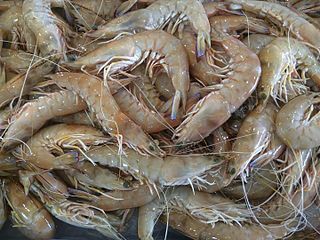Prawns in Hindi
- Hindi name of Prawns is Jhinga
Prawns in Tamil
- Tamil name of Prawns is Iraal (or) Eral (or) Ira (or) Raatu
Prawns in Telugu
- Telugu name of Prawns is Royyalu (or) Royya
Prawns in Malayalam
- Malayalam name of Prawns is Chemmeen (or) Konj (or) Konchu
Prawns in Kannada
- Kannada name of Prawns is Sigadi (or) Setle (or) Etti (or) Boli
Prawns in Bengali
- Bengali name of Prawns is Chingri
Prawns in Marathi
- Marathi name of Prawns is Kolambi (or) Kolbi

Prawn is commonly found in the Indo-West Pacific through India, Malaysia and Indonesia to China. In India, prawns are one of the major commercial species and widely exported fish. India is a competitive supplier of prawns around the world. This mainly due to the low cost of labour and the production capacity it has managed to achieve in the global space.
Seawater prawns and freshwater prawns are commonly found in India.
Marine prawns are produced mainly on Kerala and Maharashtra coasts. Normally, the prawns are grown in large paddy fields or big ponds. Compared to other producers around the world, India is considered a low-density producer, with a standard of about 40 shrimp per square meter. The black tiger prawns are the ones the Indians are highly interested to produce due to their demand and higher profitability.
Usually, prawns are fried lightly and then used in curries along with other ingredients, spices and condiments. Prawns can also be grilled.
In South India, Prawns is the main ingredient across regional dishes like Kerala prawn fry, prawn vindaloo, Chettinad prawn curry, prawn malai curry, prawn tikka masala etc.
Difference between Prawns and Shrimp
In certain countries, the names of both prawns and shrimp differ. In the United States and Australia, they use the word shrimps but in India and United Kingdom both prawns and shrimp are referred to as prawns.
The names Prawns and Shrimp seems to be the same but there is a minor difference between them. The prawns have larger legs and claws but shrimps have smaller legs and claws.
The prawns have a good gill structure than the shrimp.
Species of Prawns
There are many species of prawns found in coastal regions of India
- Penaeus indicus (Indian Prawn)
- Penaeus monodon (Tiger prawn)
- Penaeus mergniensis (Banana prawn)
- Penaeus semisulcatus (Green tiger prawn)
- Metapenaeus dobsoni (Yellow prawn)
- Penaeus sculptilis
- Penaeus stylifera
- Penaeus tenuipes
- Parapenaeopsis maxillepedo
- Palaemon fluminicola
- Metapenaeus brevicornis
- Metapenaeus affinis
- Metapenaeus Monoceros
Prawns Production in India
The demand for prawns is huge in India. The prawns started in India in late 1980 was successful, but 2010-2019 is considered as the decade of prawns farming growth. The prawns farming area in India is around 160,000 hectares and in the year 2019, the prawn’s production was 805,000 MT. The introduction of SPF L. vannamei species of the prawn was highly successful, which can grow up to 20 grams or even beyond. 90 per cent of Indian prawns production is for SPF L. vannamei.
The domestic market of prawns consumption in India is around 50,000 MT per year. The majority of the prawns produced in India are exported to countries like the US (46.7%), China(23.8%), European Union(12.1%) and Japan(6.4%). US$4.89 billion worth of prawns is exported. During the last decade, there is a growth of 430% in exporting prawns.
In India, Andhra Pradesh is leading in farmed marine prawns production over the last three decades than other states. The black tiger prawns have been produced in low-salinity waters. New ponds construction and using old ponds led to the vast production of prawns in Andhra Pradesh. Odisha, Gujarat and West Bengal are also notable states for prawns farming.
India has about 38 feed mills that produce prawns feeds and have a production capacity of 3.5 million MT. The feed sales was estimated at 1.3 million MT in 2019 which was remarkable. From an estimated 550 to 600 hatcheries, India has a production capacity of 120 billion postlarvae. In 2019, the production was 7 billion PLs.
Prawns Health Benefits
The health benefits of Prawns are endless
- Prawns contain high quality protein and a great source of Vitamins B-6, B-12 and Niacin that helps to build muscle.
- Prawns reduce bad cholesterol levels and does not allow blockage in the arteries.
- Prawn contains calcium that helps build the bones and teeth stronger.
- Prawns have low carbohydrate and aids in weight-loss.
- Prawns are high in omega-3 fatty acids that eliminates harmful cholesterol and also contains essential amino acids.
- Prawn lowers risk of heart disease and diabetics.
- Prawns help to reduce fatigue and protects against cancer.
- Prawns are rich in Selenium, the most effective antioxidants for maintaining healthy cells.
- Prawns contain high levels of Zinc that strengthens the immune system.
- Prawns have many anti-inflammatory properties.
- Prawns help to promote blood circulation.
- Prawns protect against thyroid gland disease.
Disadvantages of Eating Prawns
Prawns also have certain disadvantages.
- Prawns are high in cholesterol and increases the level of desirable HDL cholesterol.
- Prawns are highly allergic and may cause stomach problems and as well as diarrhoea.
- Prawns are hard to digest and affects the digestive system.
- Prawns are high in iodine that causes hyperthyroidism.
- Prawns are high purine food that cause uric acid to accumulate in the body, causing urinary tract stones.








